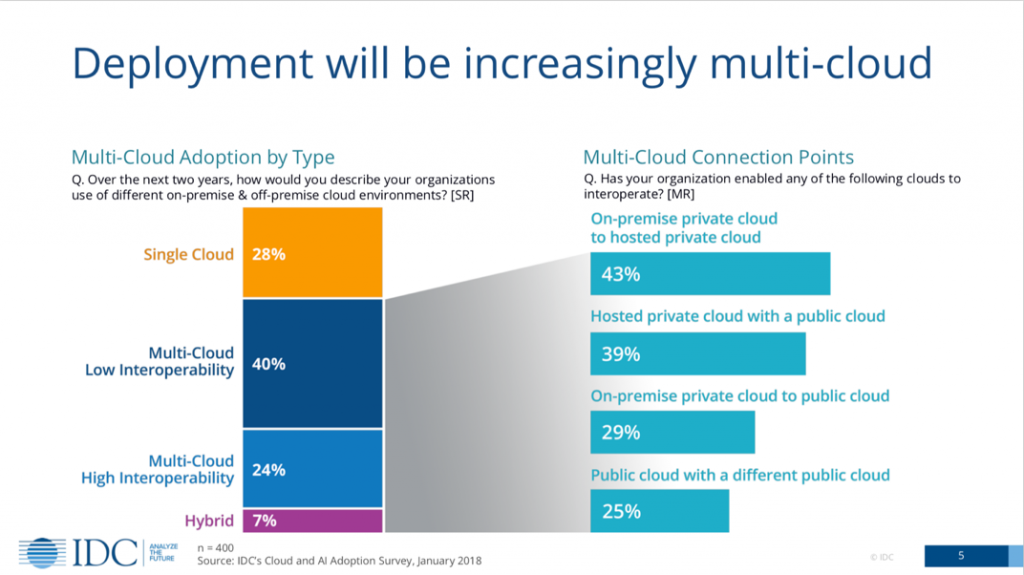Apr15

In today’s day and age, business enterprises are finding it difficult to navigate through different complex environments that run across data centers, edge, and multiple clouds. While single cloud still holds relevance, most companies are adopting multi-cloud and hybrid cloud models. However, the terms hybrid cloud and multi-cloud are inconsistently used. A multi-cloud strategy entails using multiple cloud services from different providers based on their performance levels at certain tasks.
With the deployment of multi-cloud and hybrid cloud infrastructures and it being a reality, players like Microsoft, Google, and AWS have entered this market, propelling for greater cloud innovation. All hyperscalers have built control planes for hybrid and multiple cloud deployment models, that overlook the lifecycle of managed services like Internet of Things (IoT), functions databases, virtual machines, and observability, etc.
I believe that these control planes deliver the promise of robust hybrid/multi-cloud technologies in this ever-changing multi-cloud services infrastructure. Currently, Microsoft Azure Arc and Google Anthos are the most popular control planes in this domain. However, Microsoft Azure Arc — stands out amongst others because of its unique design architecture.
In this article, I will deep dive and dissect the efficacy of Microsoft Azure Arc.
Azure Arc is a software solution that enables you to project your on-premises and other cloud resources, such as virtual or physical servers and Kubernetes clusters, into Azure Resource Manager.
Essentially, Azure Arc is an extension of Azure Resource Management (ARM) that gives support to resources running outside of Azure. It uses ARM as a framework by extending its management capabilities and simplifying the use for customers across different hybrid and multi-cloud environments. Azure Arc is about extending the Azure control plane to manage resources beyond Azure, like VMs and Kubernetes clusters wherever they are, whether they’re Windows, Linux, or any Cloud Native Computing Foundation-Certified Kubernetes distro.
Organizations can even manage resources even if they’re not always connected to the internet. Thus, non-Azure deployments can be managed alongside Azure deployments using the same user interfaces and services, such as tags and policies.
Azure Arc is a unique approach undertaken by Microsoft to accelerate innovation across hybrid and multi-cloud environments.
a.) Arc enables management and governance of resources that can live virtually anywhere (on-premises, in Azure, Azure Stack, or in a third-party cloud or at the edge). These resources can be servers, virtual machines, bare-metal servers, Kubernetes clusters, or even SQL databases. With Arc, you can use familiar Azure services and management capabilities including Create, Read, Update and Delete (CRUD) policies and role-based management.
b.) Arc provides a single pane of glass — Using the same scripting and tools, you can see those resources alongside everything else in Azure. Furthermore, they can cover, monitor, and back all these services no matter where they live.
c.) Arc enables customers to easily modernize on-premises and multi-cloud operations through a plethora of Azure management and governance services. Supports Asset organization and inventory.
d.) Arc can support enforcing organization standards and assess compliance at scale for all your resources, anywhere based on subscription, resource groups, and tags
e.) Arc also provides other cloud benefits such as fast deployment and automation at scale. For example, using Kubernetes-based orchestration, you can deploy a database in seconds by utilizing either GUI or CLI tools.
f.) Arc allows organizations to extend the adoption of consistent toolset and frameworks for Identity, DevOps / DevSecOPS, automation, and security capabilities across hybrid/multi-cloud infrastructures and lastly, to innovate everywhere.
g.) Arc supports the use of GitOps-based configuration as code management, such as GitHub, to deploy applications and configuration across one or more clusters directly from source control.
h.) Arc helps organizations to make the right decisions about cloud migrations. Using Azure Arc, you can gather the workload data (discovery) and uncover insights to decide where your workloads should run — whether on-premises, in Azure, or in a third-party cloud or at the edge. This insight-driven approach can save you significant time, effort and migration cost too.
i.) A unified experience viewing your Azure Arc enabled resources whether you are using the Azure portal, the Azure CLI, Azure PowerShell, or Azure REST API.
Azure Arc allows enterprises to manage the following resource types outside the realm of Azure:
Azure Arc-enabled servers became generally available in September 2020.
Servers, be it physical or virtual machines, running Windows or Linux, are supported by Azure Arc. Azure Arc-enabled servers are in a way considered agnostic to infrastructure for this reason. These Machines, when connected, are given an ID amongst the resource group and are deemed as another resource in Azure. Azure Arc servers enable various configuration management and monitoring tasks, making it easier for hybrid machines to have better resource management.
Additionally, service providers handling customers’ or enterprise’s in-house infrastructure, can treat hybrid machines similar to how they treat native virtual machines using Azure Lighthouse.
Managing Kubernetes applications in Azure Arc entails the attachment and configuration of Kubernetes clusters inside or outside of Azure. This could entail bare-metal clusters running on-premises, managed clusters like Google Kubernetes Engine (GKE), Amazon EKS etc.
Azure Arc enabled Kubernetes allows you to connect Kubernetes clusters to Azure for extending Azure’s management capabilities like Azure Monitor and Azure Policy. By attaching external Kubernetes clusters, users can avail all the features that enable them to control external clusters like Azure’s own internal cluster. But keep in mind, unlike AKS, the maintenance of the underlying Kubernetes cluster itself is done by you.
Azure ARC is beyond minimum viable feature approach with Kubernetes
Azure Arc enabled data services help to run data services, using your preferred infrastructure, on-premises, and at the edge. Currently, Azure Arc-enabled data services are available for preview in services like SQL Managed Instance and PostgreSQL Hyperscale. Azure Arc supported SQL Managed Instance and PostgreSQL Hyperscale can be run on AWS, Google Cloud Platform (GCP), or even in a private datacenter.
Azure Arc enabled data services such as Azure Arc enabled SQL Managed Instance and Azure Arc enabled PostgreSQL Hyperscale to receive updates on a frequent basis, including servicing patches and all the new features in Azure. Updates from the Microsoft Container Registry are provided to you and deployment cadences are set by you in accordance with your policies.
This way, on-premises databases can stay up to date while ensuring you maintain control. Because Azure Arc-enabled data services are subscription services, you will no longer face end-of-support situations for your databases.
Azure Arc enabled Data Services also support cloud-like Elastic Scale, which can support burst scenarios that have volatile needs, including scenarios that require ingesting and querying data in real-time, at any scale, with sub-second response time. In addition, you can also scale out database instances using the unique hyper-scale deployment option of Azure Database for PostgreSQL Hyperscale.
This capability gives data workloads an additional boost on capacity optimization, using unique scale-out reads and writes. Many of the services such as self-service provisioning, automated backups/restore, and monitoring can run locally in your infrastructure with or without a direct connection to Azure.
I believe companies can find this as an attractive service if they need to use cloud-based tools outside the premise of Microsoft.
Azure Arc enabled SQL Server is part of the Azure Arc for servers. It extends Azure services to SQL Server instances hosted outside of Azure in the customer’s datacenter, on the edge or in multi-cloud environment.
You must be wondering why has Microsoft introduced Azure Arc when there’s an already existing hybrid cloud service — Azure Stack? Azure Stack is a hardware solution that enables you to run an Azure environment on-premises. Whereas Azure Arc is a software solution that enables you to project your on-premises and multi-cloud resources, such as virtual or physical servers and Kubernetes clusters, into Azure Resource Manager.
For applications that use a mix of on-premises software and Azure services, local deployment of Azure services through Azure Arc can reduce the communication latency to Azure, while providing the same deployment and management model as Azure.
While Azure Stack Hub is still viable for few businesses, Azure Arc becomes a holistic strategy for organizations that are looking to offload their workloads on both private and public clouds, both off-premises, on-premises.
So, how does Azure Arc compare to other hyperscalers who are offering hybrid and multi-cloud strategies?
AWS Outposts is a fairly new solution and is currently more aligned to Hybrid Cloud deployment models. Google Anthos allows you to build and manage applications on-premises, Google cloud, and even on AWS Outposts and Microsoft’s Azure. Anthos does NOT make GCP services available in either your own data center or in other clouds. To access GCP services (storage, databases, AI/ML services, etc.), the containers running in your data centers must reach back to Google cloud.
Google Anthos and Azure Arc have very similar capabilities and approaches. Anthos is more focused on getting everything deployed to containers and has limited capabilities to manage VMs or servers running in your data center or in any third-party clouds. Additionally, Google Anthos currently might be a costly component. Moreover, according to my analysis, Google Anthos is quite prescriptive. This is because to run Google Anthos, you require GKE (Google Kubernetes Engine), be it to deploy to Google Cloud.
This isn’t the case with Microsoft’s Azure Arc as it goes beyond Kubernetes into areas like centralized discovery, a common toolset for security, configuration, management of Data Services. It also offers more choices for Kubernetes environments, giving the option to customers to choose the Kubernetes platform. Azure Arc offers more portability and less lock-in than Anthos.
Azure Arc is offered at no additional cost when managing Azure Arc-enabled servers. Add-on Azure management services (Azure Monitor, etc.) may be charged differently for Azure VMs or Azure Arc enabled servers. Service by service pricing is available on the Azure Arc pricing page. Azure Arc enabled Kubernetes clusters and Azure Arc enabled data services are in preview and are offered at no additional cost at this time.
The current roadmap as stated on the Microsoft website includes adding more resource infrastructures pertaining to servers and Kubernetes clusters. In the future, you can expect:
a.) Self-hostable gateway for API Management — allows management of APIs hosted outside of Azure using the Azure-hosted API Management service.
b.) Other database services, such as Cosmos DB, are likely to be supported by the data services feature.
c.) Furthermore, support for deploying other types of Azure services outside of Azure could be added to Arc in the future.
To encapsulate, public cloud providers are churning out services to attain a spot in your company’s on-premises data center. The growing demand for hybrid-cloud and multiple cloud platforms and services has ushered Microsoft to launch Azure Arc as part of its cloud strategy.
So, what does this innovation mean to IT infrastructures? Well, with the demand for single management systems in multi-cloud environments soaring, I think it is more than a viable option. Simply because, once you register with Azure, Microsoft Azure Arc enables enterprises to jump on the hybrid cloud bandwagon regardless of whether they own an old version of Oracle on Linux or a modern one. I think this strategy is a game-changer as it helps to simplify complex and distributed systems across various environments like on-premises, multi-cloud, and on edge. Additionally, Azure Arc can be deemed as a compelling choice for enterprises that want to maintain balance by using traditional VM-based workloads and modernized container-based workloads.
Azure Arc, can hence, distinguish itself as a legacy management tool for hybrid cloud applications infrastructure propelling for greater digital transformation. I feel the simplicity of Azure Arc will be enough to lure enterprises to adapt to it.
Keywords: Cloud, COVID19, Digital Twins
 Glimpses of Agentic Intelligence: Gemini-3-Flash Navigating Mock ARC-AGI-3 Grid Worlds
Glimpses of Agentic Intelligence: Gemini-3-Flash Navigating Mock ARC-AGI-3 Grid Worlds Leadership Vacancies are Predictable. The Costs of Being Unprepared.
Leadership Vacancies are Predictable. The Costs of Being Unprepared. The Power of Self-Love: Insights from Karl Taft and Zen Benefiel
The Power of Self-Love: Insights from Karl Taft and Zen Benefiel Every Role Is a Sustainability Role
Every Role Is a Sustainability Role The Corix Partners Friday Reading List - December 26, 2025
The Corix Partners Friday Reading List - December 26, 2025